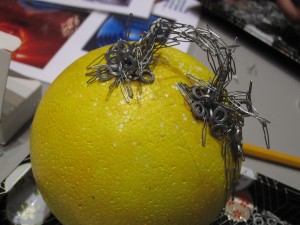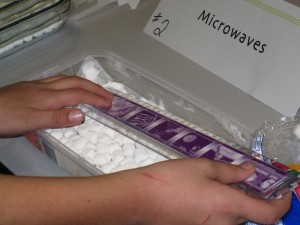13 December 2010
AGU’s “Exploration Station” and the science of light
Posted by mohi
It’s Monday morning, and people are darting in and out of Moscone West and South, clutching poster tubes and drinking coffees as they rush off to early science sessions to discuss everything from Fourier transform spectroscopy to fluid enrichment in the mantle wedge of subduction zones. But what many may not know is that science presentations began a day earlier at AGU’s Exploration Station, an outreach event where families explore science through hands-on activities.
The event began with a talk, led by W. Dean Pesnell, project scientist for NASA’s Solar Dynamics Observatory (SDO). SDO is aims to uncover minute details about the Sun and its magnetic field, with the ultimate goal of understanding how flares and other solar turbulence affects Earth. After the talk, families were treated to a bona fide science fair, complete with an inflatable planetarium, scale representations of the Sun and planets, and a huge TV screen broadcasting the latest SDO images.
Various booths guided kids in how to make a spectroscope, trace out the magnetic fields of bar magnets, and modelmagnetic loops on the Sun with metal shavings. At a booth that allowed kids to see themselves in infrared, I talked to Shaw Lenox, a 13-year-old seventh grader who attended the fair with his sisters and father. “You can’t see infrared,” he explained. “So they have to turn it into a different color so that your eyes can see it. See?” He pointed to his is face in the infrared screen, which was contoured with orange and red.
Another display showed kids how to use marshmallows to measure the speed of light. The scientist running the display began with a baking tray with marshmallows packed in one layer at the bottom like tiny puffy soldiers. He then nuked the tray in the microwave, taking care that the rotating turntable within the appliance was turned off. This allows the microwave to move through the glass and marshmallows in a standing wave pattern. After a few moments, he removed the tray and asked a kid to measure the distance between melted patches, which mark the locations of highest amplitudes within the standing wave. Converting this into meters and multiplying by 2 gives a full wavelength, and multiplying that by the frequency of the microwave gives ~299,000,000 meters per second–the speed of light!
“Cool, but now can we eat the data?” asked Shaw. I thought the same thing–what could beat learning and eating? I sneaked a marshmallow and went off to build by own spectroscope.
–Mohi Kumar, AGU Science Writer




 GeoSpace is a blog on Earth and space science, managed by AGU’s Public Information staff. The blog features posts by AGU writers and guest contributors on all sorts of relevant science topics, but with a focus on new research and geo and space sciences-related stories that are currently in the news.
GeoSpace is a blog on Earth and space science, managed by AGU’s Public Information staff. The blog features posts by AGU writers and guest contributors on all sorts of relevant science topics, but with a focus on new research and geo and space sciences-related stories that are currently in the news.